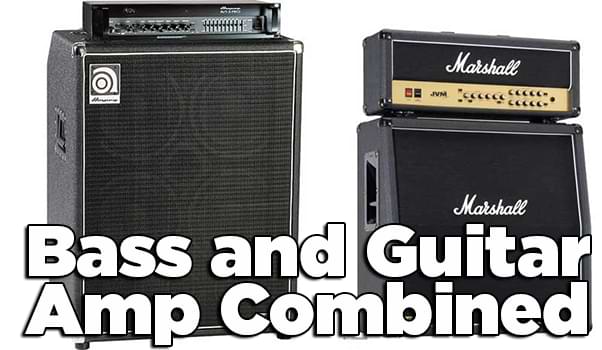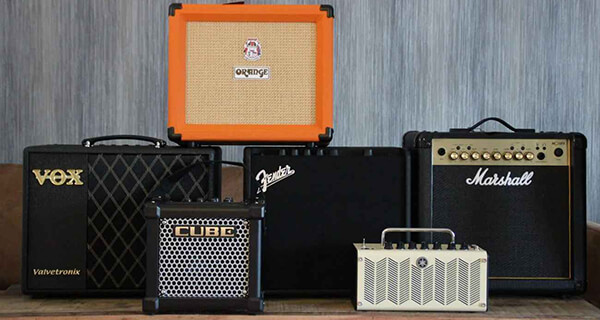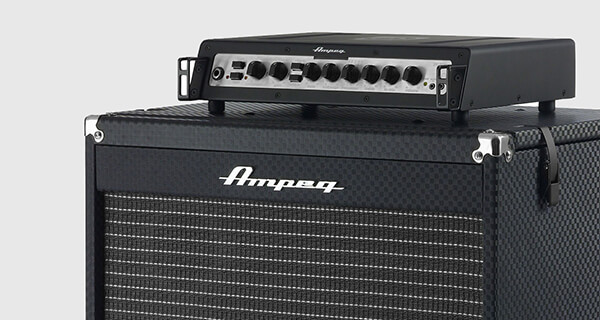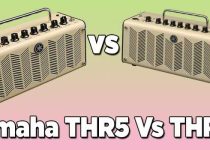Bass and Guitar Amp Combined [What is Difference]
The fusion of bass and guitar amplification into a single unit has ignited interest and discussions among musicians and gear enthusiasts. In this guide, we will uncover the intricacies of combined bass and guitar amps, exploring their unique features, benefits, and distinctions from traditional amplifiers. Join us as we delve into this innovative facet of the music world.

# Table of Contents =>
The Basics of Amplifiers:
Before we dive into the specifics of combined bass and guitar amps, let’s first establish a solid understanding of amplifiers in general.
What is an Amplifier?
An amplifier, commonly known as an “amp,” represents an electronic apparatus employed to elevate the power and magnitude of an audio signal. Within the realm of musical instruments, amplifiers assume a critical role in ensuring that the sounds generated by instruments such as electric guitars and bass guitars become perceptible at the intended volume levels.
Types of Amplifiers:
There are various types of amplifiers, each designed for specific instruments or applications. The most common types include:
i) Guitar Amplifiers:

- Designed to amplify the sound of electric guitars.
- Often come in different configurations like combo amps and head/cabinet setups.
- Known for their tone-shaping controls such as gain, EQ, and reverb.
ii) Bass Amplifiers:

- Tailored to enhance the sound of bass guitars.
- Typically focus on delivering deep, low-frequency tones.
- Feature controls for bass, midrange, and treble adjustments.
The Role of Amplifiers in Music –
Amplifiers hold a pivotal role in molding the holistic sound of a musical instrument. They serve not only to amplify the instrument’s volume but also to exert a significant influence on its tonal qualities. Musicians frequently make amplifier selections guided by their personal sonic preferences, musical style, and the particular genre they engage in.
The Emergence of Bass and Guitar Amp Combined –
The Need for Versatility:
In the ever-evolving world of music, musicians are constantly seeking ways to expand their sonic palette. Guitarists who occasionally play bass, and vice versa, began to desire amplifiers that could cater to both instruments without requiring multiple amp setups. This demand paved the way for the development of combined bass and guitar amps.
Features of Combined Amps:
Combo amps, frequently denoted as “combined amplifiers,” present a variety of features that greatly appeal to musicians in search of versatility:
i) Dual Channels:
Most combo amps include separate channels for bass and guitar, each with its own set of controls. This allows musicians to switch between instruments seamlessly during a performance.
ii) EQ and Tone Shaping:
Combo amps typically provide extensive EQ options for both bass and guitar channels. Musicians can fine-tune their tone by adjusting parameters like bass, midrange, treble, and presence.
iii) Effects and Built-in Processing:
Many combined amps come equipped with built-in effects such as reverb, delay, and chorus. This eliminates the need for external effects pedals, reducing setup complexity.
iv) Power and Volume:

Combo amps are designed to handle the power requirements of both bass and guitar. They offer sufficient wattage to produce adequate volume levels for live performances.
v) The Advantages of Combined Amps
The emergence of combined bass and guitar amps has brought several advantages to musicians:
vi) Space & Portability:
Rather than lugging around individual amplifiers for both bass and guitar. Musicians can depend on a single combo amp, which not only conserves space. But also lessens the equipment load during live performances.
vii) Cost-Efficiency:
Owning a single amplifier that caters to both instruments can be more cost-effective than purchasing two separate amps.
viii) Seamless Live Performances:
Musicians can switch between bass and guitar effortlessly during live performances, enhancing the overall versatility of their shows.
ix) Streamlined Sound Control:
Combo amps simplify the process of managing tone and effects, as everything is consolidated into a single unit.
Understanding the Differences –
While combined bass and guitar amps offer remarkable versatility, it’s crucial to understand the differences between them and traditional guitar or bass amps.
a) Tonality Differences:
Traditional guitar and bass amplifiers are designed with a specific instrument’s tonal characteristics in mind. Guitar amps emphasize mid-range frequencies and can deliver rich overdrive and distortion tones. Bass amps are optimized for low-end frequencies and provide clean, deep bass tones.
Combined amps aim to strike a balance, accommodating both instruments. However, this means they may not excel in producing the extreme tonal characteristics that dedicated guitar and bass amps can achieve. Musicians must consider whether the compromise in tonal purity aligns with their musical goals.
b) Speaker Size & Configuration:

A significant contrast can be found in the size and setup of speakers. Bass amplifiers typically incorporate larger speakers, such as 15-inch or 12-inch models, to effectively reproduce the low-frequency tones generated by a bass guitar. In contrast, guitar amplifiers often utilize smaller speakers, typically 10-inch or 12-inch variants, which are finely tuned for midrange frequencies.
c) Wattage & Power Handling:
The wattage and power handling of an amplifier can significantly impact its performance. Dedicated bass amps often have higher wattage ratings to accommodate the demands of low-frequency sound reproduction. Guitar amps can have lower wattage ratings but excel in creating distortion at lower volumes.
Combined amps strike a balance in terms of wattage, offering enough power for both instruments. However, this means they might not excel in extreme distortion or ultra-clean bass tones, which are achievable with specialized amps.
d) Effects & Processing:
Combined amps frequently come equipped with built-in effects and processing capabilities. While this can be convenient for musicians looking to simplify their setup, it may not match the versatility and quality of standalone effects pedals or dedicated processors.
Musicians who rely on a wide array of effects or demand the highest level of control over their sound may find that combined amps fall short in this regard. However, for those seeking a straightforward and hassle-free approach, the built-in effects can be a valuable asset.
Choosing the Right Amp for Your Needs –
a) Consider Your Musical Style:
The choice between a combined bass and guitar amp or dedicated amplifiers largely depends on your musical style. If you primarily play one instrument and require specific tonal characteristics, it’s advisable to invest in a dedicated amp. For example, if you’re a bassist in a heavy metal band, a powerful bass amp with high wattage and distortion capabilities would be essential.
b) Evaluate Your Performance Needs:
Consider the demands of your live performances. Are you frequently switching between bass and guitar during a set? In this case, a combined amp can simplify your setup and streamline your performances. However, if you have dedicated moments for each instrument and require specialized tones, using separate amps might be more suitable.
c) Assess Your Space and Budget:
Practical considerations like space and budget also play a crucial role in your amplifier choice. A combined amp can save space and potentially reduce expenses compared to buying two separate amplifiers. If you’re limited on stage space or working with a tight budget, a combo amp may be the most practical solution.
d) Experiment and Listen:
Ultimately, the best way to determine the right amp for your needs is to experiment and listen. Try out different amplifiers, both combined and dedicated, to get a feel for their tonal characteristics and features. Listen to how they respond to your playing style and instruments. This hands-on approach will help you make an informed decision that aligns with your musical goals.
Notable Combined Bass and Guitar Amps –
To assist you in your search for the perfect combined amp, here are some notable models known for their versatility and quality:
i) Fender Bassbreaker 18/30 Combo:
A versatile combo amp that combines the classic Fender clean tones with the capability to handle both bass and guitar.
ii) Ampeg BA-108 V2
A compact combo amp that’s great for practicing and small gigs, suitable for both bass and guitar.
iii) Vox VX50 KB
A portable and lightweight combo amp with built-in effects, perfect for musicians on the move.
iv) Roland Blues Cube Hot “British EL84 Modified”
A versatile combo amp with an authentic tube amp sound, suitable for both bass and guitar.
v) Orange Crush Bass 50
A powerful combo amp designed for bass, but with the flexibility to accommodate guitar as well.
Conclusion:
The world of combined bass and guitar amplifiers offers a unique solution for musicians seeking versatility and convenience. While these amps can certainly simplify your setup and streamline your performances, it’s essential to understand their differences compared to dedicated guitar and bass amplifiers. Ultimately, the choice between a combined amp and separate amplifiers depends on your musical style, performance needs, space, and budget.
As you embark on your journey to find the perfect amplifier, remember to experiment, listen, and prioritize your specific musical goals. Whether you opt for a combined bass and guitar amp or choose to stick with dedicated amplifiers, the key is to find the equipment that helps you achieve your desired sound and enhances your musical journey.
Last Updated on September 19, 2023 by Perry Garner


